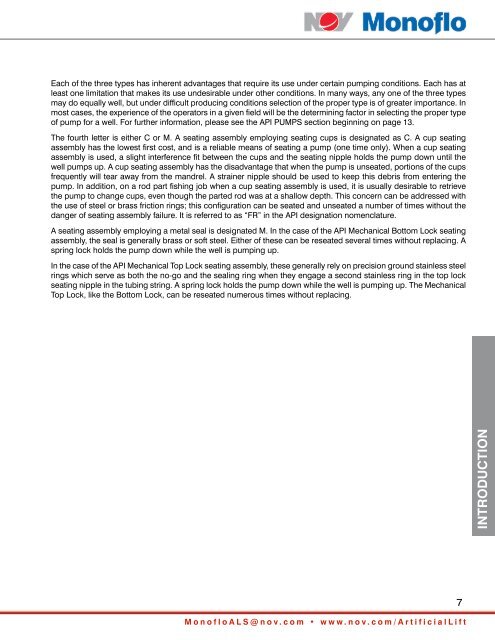Rod Pumps and Components - Production Solutions
Rod Pumps and Components - Production Solutions
Rod Pumps and Components - Production Solutions
Create successful ePaper yourself
Turn your PDF publications into a flip-book with our unique Google optimized e-Paper software.
Each of the three types has inherent advantages that require its use under certain pumping conditions. Each has at<br />
least one limitation that makes its use undesirable under other conditions. In many ways, any one of the three types<br />
may do equally well, but under difficult producing conditions selection of the proper type is of greater importance. In<br />
most cases, the experience of the operators in a given field will be the determining factor in selecting the proper type<br />
of pump for a well. For further information, please see the API PUMPS section beginning on page 13.<br />
The fourth letter is either C or M. A seating assembly employing seating cups is designated as C. A cup seating<br />
assembly has the lowest first cost, <strong>and</strong> is a reliable means of seating a pump (one time only). When a cup seating<br />
assembly is used, a slight interference fit between the cups <strong>and</strong> the seating nipple holds the pump down until the<br />
well pumps up. A cup seating assembly has the disadvantage that when the pump is unseated, portions of the cups<br />
frequently will tear away from the m<strong>and</strong>rel. A strainer nipple should be used to keep this debris from entering the<br />
pump. In addition, on a rod part fishing job when a cup seating assembly is used, it is usually desirable to retrieve<br />
the pump to change cups, even though the parted rod was at a shallow depth. This concern can be addressed with<br />
the use of steel or brass friction rings; this configuration can be seated <strong>and</strong> unseated a number of times without the<br />
danger of seating assembly failure. It is referred to as “FR” in the API designation nomenclature.<br />
A seating assembly employing a metal seal is designated M. In the case of the API Mechanical Bottom Lock seating<br />
assembly, the seal is generally brass or soft steel. Either of these can be reseated several times without replacing. A<br />
spring lock holds the pump down while the well is pumping up.<br />
In the case of the API Mechanical Top Lock seating assembly, these generally rely on precision ground stainless steel<br />
rings which serve as both the no-go <strong>and</strong> the sealing ring when they engage a second stainless ring in the top lock<br />
seating nipple in the tubing string. A spring lock holds the pump down while the well is pumping up. The Mechanical<br />
Top Lock, like the Bottom Lock, can be reseated numerous times without replacing.<br />
MonofloALS@nov.com • www.nov.com/ArtificialLift<br />
7<br />
Int<strong>Rod</strong>uCtIon


